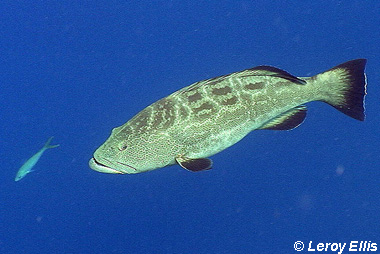
Mycteroperca bonaci
This oblong reef fish has small eyes over a protruding lower jaw, and a continuous dorsal fin that leads back to its square caudal (tail) fin. It’s an olive gray color with dark blotches and bronze hexagonal shapes on its head and sides. Like most groupers, these all start out as females, and then at a certain age and size, they become males. They prefer the rocky bottoms around reefs in the Western Atlantic, where they eat smaller fish and crustaceans, and grow to almost 52 inches long.
Order: Perciformes
Family: Serranidae
Genus: Mycteroperca
Species: bonaci
Common Names
English language common names include: black grouper, black rockfish, rockfish, and marbled rockfish. Black groupers are referred to by many common names worldwide including: abade bonaci (Mexico), aguaji (Cuba), badeche bonaci (France), badejo-ferro, badejo-preto, badejo-quadrado (Brazil), bonaci (Cuba), bonaci arrara (Cuba), bonaci gato (Mexico), bonaci-havaborre (Denmark), bonaci arara (UK), cerigado-preto (Brazil), cherna (Colombia), cuna (Spain), cuna bonaci (Nicaragua), cuna guarei (Venezuela), djampau (NethAntilles), guajil (Puerto Rico), mero (Dominican Republic), mero pinto (Puerto Rico), merou (France), perka marmurkowa (Poland), quadradinho (Brazil), Schwarzer Zackenbarsch (Germany), serigado, serigado-preto, sirigado (Brazil), and svart grouper (Sweden).
Importance to Humans
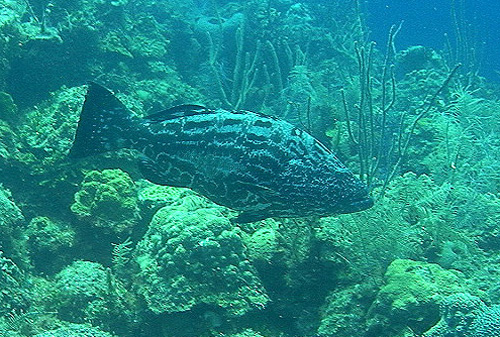
Black groupers are commonly landed in commercial grouper fisheries in the Gulf of Mexico and the south Atlantic Ocean. They are also very common in the recreational fishery. The meat generates a fairly high price and is considered very good quality.
Danger to Humans
There have been reported cases of ciguatera from human consumption of black grouper. Ciguatera poisoning is caused by dinoflagellates (microalgae) found on dead corals or macroalgae. By feeding on these corals and macroalgae, herbivorous fishes accumulate a toxin generated by these dinoflagellates. Largely a phenomenon of tropical marine environments, ciguatoxin accumulates still further in snappers and other large predatory reef species that feed on these herbivorous fishes. If accumulated levels of the toxin are great enough they can cause poisoning in humans whom consume the flesh of these fishes. Poisoned people report having gastrointestinal problems for up to several days, and a general weakness in their arms and legs. It is very rare to be afflicted with ciguatera poisoning.
Conservation
Black grouper are fished both recreationally and commercially in waters around Florida, in particular the Gulf of Mexico. Black grouper must be at least 22 inches (55.9cm) to land recreationally and 24 inches (60.0cm) inches to land recreationally. Black groupers do not mature until they grow past 28 inches (71.1cm), landing them at sizes smaller than this may be detrimental to black grouper populations, because many animals landed may not be given the opportunity to reproduce.
> Check the status of the black grouper at the IUCN website.
The IUCN is a global union of states, governmental agencies, and non-governmental organizations in a partnership that assesses the conservation status of species.
Geographical Distribution
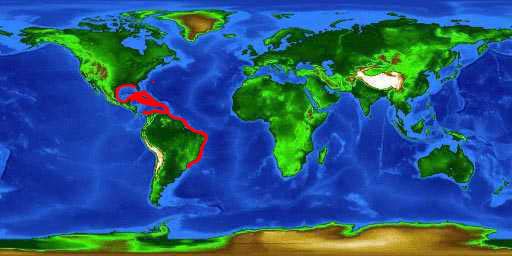
The black grouper is found throughout the western Atlantic Ocean. The northern boundary of its range is off Massachusetts and extends east to Bermuda. The range extends south to southern Brazil. It is also present in Gulf of Mexico and the Caribbean Sea, including the Florida Keys and Cuba.
Habitat
Black groupers are found mainly on rocky bottoms and in coral reef environments. Their depth ranges from anywhere from 19 to 108 feet (6 to 33 meters). Juvenile black groupers are also found in seagrass beds off of the coast of Florida.
Biology
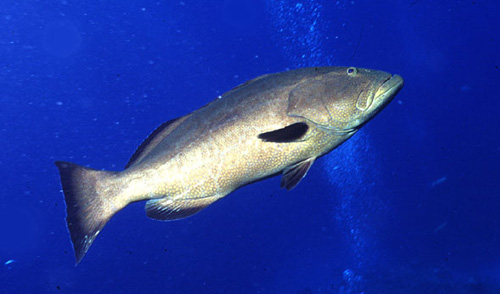
Distinctive Features
The black grouper is a large hearty fish with a protruding lower jaw. It has an oblonged body shape and rounded margins on both the dorsal and anal fins. The caudal fin is squared-off, and the dorsal fin has 11 spines and 15-17 rays. The preopercule is rounded without the presence of a notch, which distinguishes it from the gag grouper (Mycteroperca microlepis).
Coloration
The black grouper has olive or gray body coloration along with dark rectangular blotches and small hexagonal bronze spots on its head and lower side. The borders of the soft dorsal, anal, and caudal fin is black or bluish; sometime there is an orangish edge along the pectoral fins.
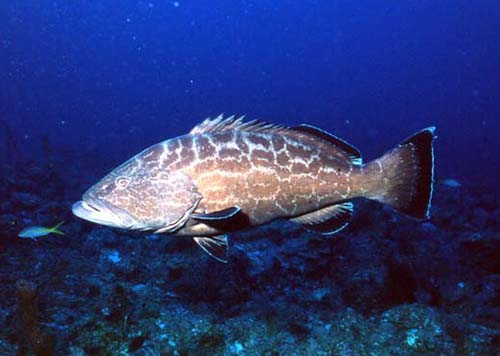
Dentition
The front teeth of the black grouper are well-developed canine teeth. Groupers have several sets of strong, slender teeth that act as raspers. These teeth are not used to tear flesh as with the barracudas and sharks, but rather to prevent small fish from escaping.
Size, Age, and Growth
Black groupers can reach up to 52 inches (133 cm) in length and can weigh up to 179 pounds (81 kg). Most of the black grouper that are caught average a little over 2 feet in length (70 cm). They can live over 30 years, but most of the growth occurs during the first ten years of life.
Food Habits
Adult black grouper feed primarily on other smaller reef fishes, including grunts, snapper, and herrings. They also feed on crustaceans. Juvenile black groupers feed solely on crustaceans.
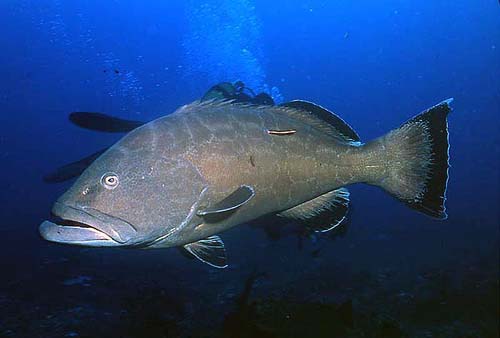
Reproduction
Black grouper are protogynous hermaphrodites. This means that all of the fish are born as females. Later in life, some of the fish will change from male to female so the population can reproduce. Those black groupers that go through this process, do so when they reach about 39 – 47.8 inches (99.0 – 121.5 cm). They are reproductively active from November through May.
Predators
Common predators of black grouper are sandbar sharks (Carcharhinus plumbeus) and great hammerhead (Sphyrna mokarran). They may also be preyed upon by barracuda (Sphyraena barracuda) and moray eels.
Parasites
Black groupers are have several common parasites all of which effect the stomach and intestines. These parasites include trematodes, cestodes, and nematodes.
Taxonomy
The black grouper was originally described as Serranus bonaci by Poey in 1860, but advances in serranoid phylogeny have changed the proper name to Mycteroperca bonaci. Synonyms for the black grouper include: Serranus brunneus Poey 1860, Serranus decimalis Poey 1860, Serranus cyclopomatus Poey 1861, Serranus latepictus Poey 1861, Trisotropis aguaji Poey 1867, Mycteroperca bonaci xanthosticta Jordan and Swain 1885.
Prepared by: Travis Ford